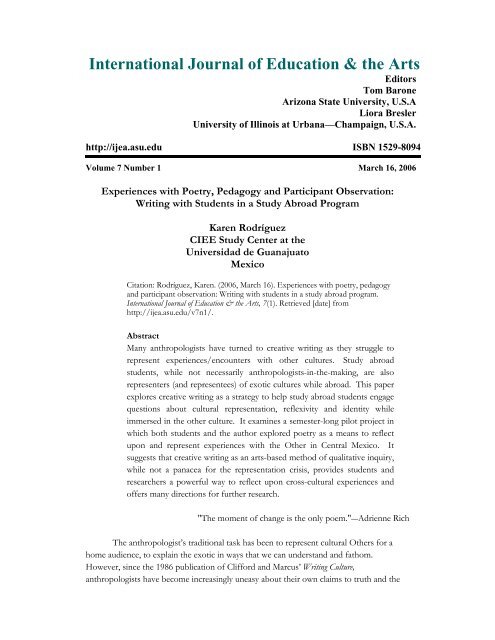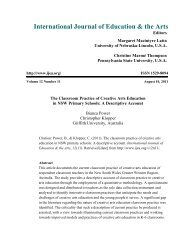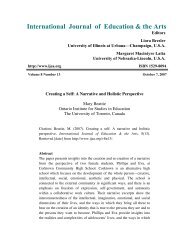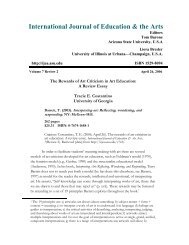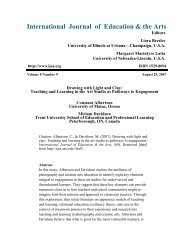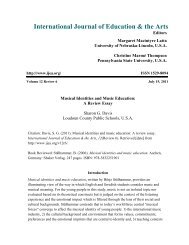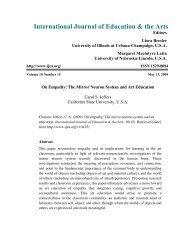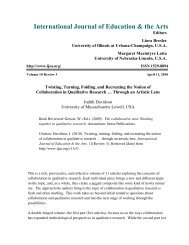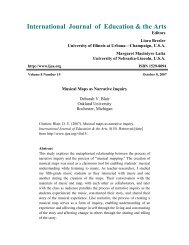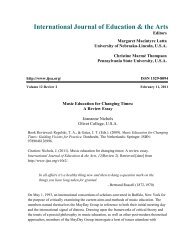Experiences with poetry, pedagogy and participant observation ...
Experiences with poetry, pedagogy and participant observation ...
Experiences with poetry, pedagogy and participant observation ...
- No tags were found...
Create successful ePaper yourself
Turn your PDF publications into a flip-book with our unique Google optimized e-Paper software.
International Journal of Education & the ArtsEditorsTom BaroneArizona State University, U.S.ALiora BreslerUniversity of Illinois at Urbana—Champaign, U.S.A.http://ijea.asu.edu ISBN 1529-8094Volume 7 Number 1 March 16, 2006<strong>Experiences</strong> <strong>with</strong> Poetry, Pedagogy <strong>and</strong> Participant Observation:Writing <strong>with</strong> Students in a Study Abroad ProgramKaren RodríguezCIEE Study Center at theUniversidad de GuanajuatoMexicoCitation: Rodríguez, Karen. (2006, March 16). <strong>Experiences</strong> <strong>with</strong> <strong>poetry</strong>, <strong>pedagogy</strong><strong>and</strong> <strong>participant</strong> <strong>observation</strong>: Writing <strong>with</strong> students in a study abroad program.International Journal of Education & the Arts, 7(1). Retrieved [date] fromhttp://ijea.asu.edu/v7n1/.AbstractMany anthropologists have turned to creative writing as they struggle torepresent experiences/encounters <strong>with</strong> other cultures. Study abroadstudents, while not necessarily anthropologists-in-the-making, are alsorepresenters (<strong>and</strong> representees) of exotic cultures while abroad. This paperexplores creative writing as a strategy to help study abroad students engagequestions about cultural representation, reflexivity <strong>and</strong> identity whileimmersed in the other culture. It examines a semester-long pilot project inwhich both students <strong>and</strong> the author explored <strong>poetry</strong> as a means to reflectupon <strong>and</strong> represent experiences <strong>with</strong> the Other in Central Mexico. Itsuggests that creative writing as an arts-based method of qualitative inquiry,while not a panacea for the representation crisis, provides students <strong>and</strong>researchers a powerful way to reflect upon cross-cultural experiences <strong>and</strong>offers many directions for further research."The moment of change is the only poem."―Adrienne RichThe anthropologist’s traditional task has been to represent cultural Others for ahome audience, to explain the exotic in ways that we can underst<strong>and</strong> <strong>and</strong> fathom.However, since the 1986 publication of Clifford <strong>and</strong> Marcus’ Writing Culture,anthropologists have become increasingly uneasy about their own claims to truth <strong>and</strong> the
International Journal of Education & the Arts Vol. 7 No. 1 2power dynamics that go into writing about the Other. As a result, many now tend to enterinto near paralysis when it comes time to write, not sure where they have expertise, whattheir research means to all involved, <strong>and</strong> how to honor both their own <strong>and</strong> Others’experiences in the research process.More positively however, this crisis of representation has provoked a notablewillingness <strong>and</strong> desire to experiment <strong>with</strong> new forms in the hopes of producing thinkingthat extends beyond the usual paradigmatic limits. While older works of anthropologyfollowed fairly traditional outlines, recent anthropology now sometimes reads like fiction or<strong>poetry</strong>. We also find collaboratory, dialogic projects where “subjects” have become coauthorsin unusual ways, <strong>and</strong> see an exp<strong>and</strong>ing range of even more hybrid, fragmentaryforms of writing that challenge how we present knowledge. The final products ofanthropological attempts to represent cultural Others <strong>and</strong> their realities look more variedthan ever, <strong>and</strong> interpretation is left increasingly in the h<strong>and</strong>s of the reader.Study abroad students, while not necessarily anthropologists-in-the-making,nonetheless share many of the same tasks while they are in the field site. Indeed, one ofthe most important challenges they take on (consciously or not) is that of culturalrepresentation. They represent the Other daily in emails home, in conversations <strong>with</strong>friends <strong>and</strong> family, in essays <strong>and</strong> in class. They are called upon to discuss what the Otherlooks like, acts like <strong>and</strong> may even think like, from the moment they arrive in a new site –notably, long before they feel anything like experts. While they are abroad, they alsorepresent the US for locals, whether physically just by being observable, or verbally, inconversations <strong>with</strong> homestay families, peers, <strong>and</strong> professors. When they return to theStates, students continue to represent the Other often in contexts that call for extremelyconcise responses to extremely broad questions, such as “So, what are Mexicans like?” Inmore than a few ways, they lack the advantages that anthropologists theoretically have –articulation that follows experience <strong>and</strong> reflection; a longer page limit or more floor time;<strong>and</strong> an educated, interested audience.That said, students’ multiple acts of representation become especially significantsince perhaps even more than anthropologists, students “take home the news” to asegment of the population that might not normally hear about such things. They thus playa role of public intellectual in a more intense, less elitist sense than most anthropologistsusually do. And one could argue that representing exotic cultures to such characters as theroommate who hates travel, or the ever-so-slightly racist gr<strong>and</strong>father, may indeed do moreto change the status quo than flashy academic publications <strong>and</strong> presentations.Study abroad experiences, which play a rapidly exp<strong>and</strong>ing part in US higher education, areintended to give university students increased underst<strong>and</strong>ing about cultural Others, whichideally will be transformative at both the personal <strong>and</strong> social level. This underst<strong>and</strong>ing isdesperately needed in a multicultural society that has limited conceptualizations <strong>and</strong> skillsfor interacting <strong>with</strong> cultural difference. Although pedagogical work in study abroad isscant, researchers have noted the key role that writing serves as a way to learn whilesojourning in another culture (Wagner <strong>and</strong> Magistrale, 1995; Hess, 1997). To date,however, there has been little critical work to examine what students write, how they write,<strong>and</strong> whether or not they have actually challenged any of their previously held ideologies
Rodríguez: Poetry, Pedagogy, <strong>and</strong> Participant Observation 3in the process. In this author’s teaching experiences, all too often, the “A” paper iswell-organized <strong>and</strong> nicely written, but only serves to reaffirm the student’s identity asculturally superior <strong>and</strong> the host culture’s identity as weird, inefficient, dangerous, orwrong.Getting US study abroad students thinking critically about cultural representation,then, is a rather immediate <strong>and</strong> urgent concern <strong>with</strong> the potential to contribute, howevermodestly, to social change. If anthropologists, cultural representers by profession, arefinding the need to experiment <strong>with</strong> creative forms <strong>and</strong> arts-based methods of inquiry inorder to transcend their own paradigmatic limitations <strong>and</strong> to find more ethical ways torepresent Other cultures, perhaps study abroad students would be well-served to do thesame.This article discusses a pilot project in which study abroad students <strong>and</strong> the author,director of their study abroad program, explored <strong>poetry</strong> writing as a method to reflect upon<strong>and</strong> represent experiences <strong>with</strong> the Other in Guanajuato, a university town of about 75,000in Central Mexico. While both the process <strong>and</strong> products of this project turned out to bequite unexpected in some ways, I suggest that <strong>poetry</strong> writing as an arts-based method ofqualitative inquiry offers us a powerful way to reflect upon experiences in other cultures<strong>and</strong> to re-think cultural representation, an insight that could be usefully applied in bothanthropology <strong>and</strong> international education whether one remains specifically <strong>with</strong>in <strong>poetry</strong> orturns to other creative forms.Creative Writing <strong>and</strong> Learning: Pedagogical Possibilities 1There are several ways in which creative writing can enhance learning during animmersion experience in another culture, all of which have pedagogical implications as faras how <strong>and</strong> to what ends we might incorporate this sort of writing into a curriculum. First,students can use creative writing like qualitative researchers, as a means through which tocollect, organize <strong>and</strong> reflect upon data obtained in a field experience, which contributes totheir learning process. Second, they can use writing as a way to represent what they learn,or as a research product, which many anthropologists <strong>and</strong> others are doing. And finally,creative writing could also be used as pedagogical tool <strong>with</strong> which to push learning inempowering or resistant directions. Because the <strong>poetry</strong> project engaged <strong>and</strong> often blendedall three of these possibilities, a brief review of how creative writing lends itself to learningcan frame the more specific insights gained through <strong>poetry</strong> use in this project.Creative writing as a qualitative research methodOne way in which students could use creative writing is as a method. As aqualitative research method, creative writing forms part of what educators call arts-basedmethods of inquiry, which conform a set of qualitative methods that have been discussed1. Written permission to cite student work was obtained from all students whose <strong>poetry</strong> <strong>and</strong>comments appear in the article.
International Journal of Education & the Arts Vol. 7 No. 1 6potential of impacting directly on individual <strong>and</strong> collective empowerment. They becomemore than empirical data <strong>and</strong> transcend their static destiny as archival documents.” (p. 9).In related fashion, critical <strong>pedagogy</strong> followers/practitioners have also used creativewriting in the classroom as a means through which to question the status quo, deconstructone’s ideas, <strong>and</strong> work towards social change. These too valorize personal experience asexpert knowledge, <strong>and</strong> highlight the relationships between the personal <strong>and</strong> the social <strong>with</strong>a keen eye towards unmasking how power <strong>and</strong> ideology function in this relationship.Words are seen as shaping reality <strong>and</strong> society, so it follows that learning to write in newways could lead to re-thinkings of society. Following Dewey, language recovers itsdynamic power to communicate <strong>and</strong> challenge ideas, rather than simply reproducing theideas of others (Shor <strong>and</strong> Pari, 1999, p. 10).Although the question of empowering students of (relative) privilege who come toMexico to study abroad is exceedingly tricky in terms of power, it is important for students<strong>and</strong> researchers to be able to take ownership of their cultural experiences <strong>and</strong> difficulttimes that occur while in the field. It is equally important to be able to confront the imagesthat the Other makes of Self, <strong>and</strong> these themes will also come up in the <strong>poetry</strong> project.The Poetry ProjectIn the fall of 2004, about a month into the semester abroad, I proposed to mystudents that we form a <strong>poetry</strong> group. I was exploring the theme of “students writingculture” for a panel I was going to be on in the spring, <strong>and</strong> serendipitously, the members ofour small semester group all happened to write stories <strong>and</strong> poems for pleasure at leastoccasionally. They agreed to participate in weekly meetings unconnected to class or otherprogram affairs <strong>and</strong> to bring in their writing 1 to share as a group. I told them that I wouldparticipate not as a teacher, but as a researcher <strong>and</strong> (very nervously) as a writer. Themeetings provided us all <strong>with</strong> a point of intersection that would not have otherwiseoccurred, since despite the small size of the group <strong>and</strong> the fact that it was all-female, therewas considerable diversity <strong>and</strong> a certain respectful distance between the <strong>participant</strong>s. Whilethey were also in a class I taught, it is unlikely any of us would have shared our work <strong>and</strong>our thoughts in this particular way <strong>and</strong> in so much depth.There is a rather long history of previous attempts to incorporate creative work intothe study abroad programs I have directed, however, I had stopped using creative work forseveral reasons. First, while much of the student work was wonderful, much of it was not.Poor work was certainly useful – for example, if at mid-semester, students producedmaudlin, over-romanticized (positively or negatively) portrayals of a culture, this provided agood indicator of where students were intellectually. It could also be argued that while inessays, students can posture <strong>and</strong> orient towards what the teacher wants to hear, in morecreative formats, the tricks are less known, so there is a possibility that an original formmight lead to more authentic / less contrived content. However the question of how toevaluate the quality of their creative work for a grade needed more addressing since moststudents were not formally trained in this sort of writing.
Rodríguez: Poetry, Pedagogy, <strong>and</strong> Participant Observation 7Much more important however, had been my own increasing unease <strong>with</strong> theknowledge that I had never been asked in my academic life to represent anything creativelyin verbal or non-verbal ways. Pedagogically, the critical notion of being a co-learner on amore equal footing <strong>with</strong> one’s students made it seem patently unethical to assign what Ihad never tried to do for school/public consumption, or was not also in the process oflearning.My main goal <strong>with</strong> this pilot project in Guanajuato, then, was to create a grade-freeenvironment <strong>with</strong> more or less committed writers in which I would also participate to seewhat the ideal situation could look like. From this experience, in which students wouldhave a less constrained voice than in graded, class assignment work, I hoped to later thinkabout how to insert creative writing into the curriculum in more intentional ways thatwould have greater chances at being successful on the different levels at h<strong>and</strong>, <strong>and</strong>eventually incorporate other art-forms as well.Within our group, we agreed to bring in <strong>poetry</strong> to share <strong>with</strong> one another. Thestudents did not have a particular set of issues in mind for discussion, so the questions Isuggested we analyze when looking at each piece, were:- What does it say about your experience in another culture?- What does it say about the other culture?- What are you getting here that would be harder to capture in a traditional essay orassignment?- What might you not be getting?- How close can we get? (Where are the ethical, empathic <strong>and</strong> other limits we bumpup against in this sort of writing?)I was particularly interested in this last question. The idea of writing from otherpoints of view sounded anthropologically downright dangerous, <strong>and</strong> I was not sure aboutwhere I stood on this issue.Our initial discussion involved some heated debate over Memoirs of a Geisha, a storyof a Japanese geisha written by American male author, Arthur Golden, in which weimmediately broached the question of who has the “right to write” what. I also providedstudents three poems about immigrants’ language-related experiences in the US,deliberately cutting out the names, immigration status, <strong>and</strong> genders of the authors. No onewas able to tell simply from reading which author was the anglo researcher-poet, which wasthe recent immigrant, <strong>and</strong> which was second-generation, <strong>and</strong> genders were guessedincorrectly in at least two cases. This unsettled the idea that a cultural outsider could neveracquire knowledge <strong>and</strong> develop enough sensitivity to actually write a credible albeit fictionalpiece from the Other point of view. It also humbled us as readers <strong>and</strong> interpreters whomight think we could easily see through any pretenses. So this established both thepossibilities in writing <strong>and</strong> the limits of our own interpretive powers.Over the next few weeks, we read several poems by different authors writing aboutforeign cultures. Rapidly however, we moved away from reading others’ works <strong>and</strong> more
International Journal of Education & the Arts Vol. 7 No. 1 8towards simply coming together to discuss <strong>and</strong> get feedback on our own work. Preparationwas not needed to keep things going or to stimulate discussion, <strong>and</strong> while I would bringquestions to meet my own agenda, I also became, frankly, much more interested in reading<strong>and</strong> learning about students’ work <strong>and</strong> writing processes. While a more structured – writethis, try that, now this model, now that format – style would have created data that was easier toanalyze, as a pilot project, it seemed important to let students take their writing <strong>and</strong> take mewherever everything naturally needed to go. In this way, no one was writing “for theteacher” or writing towards research goals, nor were we forcing inspiration to mould itselfto a given path, which hopefully will translate into a better-conceived second phase of thisproject.The Process: Writing <strong>Experiences</strong> into PoetryWhat sorts of things happened in this process? As we all wrote our experiences inMexican culture into <strong>poetry</strong> (<strong>and</strong> in one case, prose), many interesting issues emerged. Thethree themes that I will discuss here each show that <strong>poetry</strong> writing <strong>and</strong> discussing producedqualitative data about students’ experiences in Mexican culture (which has qualitativeresearch interest); produced new relationships <strong>with</strong>in the students-culture-teacher triad(which is the critical <strong>and</strong> pedagogical interest), <strong>and</strong> lead us to new reflections about creativewriting as a way to represent experiences in another culture (which is the anthropologicalor representation interest). These three interests will be woven into the discussion of eachtheme.Insight into the first person – third person question: “Writing at arm’s length”One of the most relevant discussions that developed from student writing focusedhow close <strong>and</strong> in what ways writing allowed us into the experience of an Other. Thequestions I most hoped to get answered – could we find new in-roads to empathy? – <strong>and</strong> couldwe/should we represent the Other in the first person? – did not get fully answered, in part, becausethey are so complicated, <strong>and</strong> in part, because somewhat against my expectations, the <strong>poetry</strong>group did not provoke a large quantity of writing from other viewpoints. Only one poemwas written in the first person about a local community member, <strong>and</strong> only a few poemswere written explicitly about local views even in the third person, which students statedthat they viewed as a safer way of writing about the Other since it still acknowledged thecultural <strong>and</strong> personal distance between writer <strong>and</strong> subject.However, while there were few first-person poems, these few were exceedingly welldone. For example, one student wrote a poem entitled “Low Visibility,” from the point ofview of a woman sitting on the street begging.Low VisibilityThe empty cup of my h<strong>and</strong>means nothing to you;the dusted rust of my complexionis one you feelslyly corroding a deep hole,
Rodríguez: Poetry, Pedagogy, <strong>and</strong> Participant Observation 9into your jingly pants pocketthatpatter of pesosyou’d rather me not hearas you hurry past.Like a raw, aged broom,the tired threads of my shawlsweep these illusory streets of cleanlinessinto this breathing pileof fixed filth at your feet;those same two hesitant feetthat dodge the grays of my eyes,but in their blindnesswonder if the povertybeneath me is cushioned by the pillowof my other, invisible h<strong>and</strong>filled <strong>with</strong> riches.The poem’s physical form echoes the theme in that it is placed off to the side of thepaper, away from the left-justified title. The student writes of the woman viewing thestudent, accusing her of looking away, even while she is able to observe enough to writethe poem. This is model work on several fronts. First, it offers a concise thick description ofone person. Second, it engages the observed <strong>and</strong> permits her to observe back. It is alsoempathic/compassionate writing that nonetheless takes a hard look at the powerrelationship tangibly there between the two. And finally, it is imaginative, because one doesnot know exactly what the woman is thinking, nor was a conversation initiated. On allaccounts, it “rings true,” <strong>and</strong> works in the way one would hope.In another poem, the same student wrote in the third person about a woman sellinghot dogs at a street st<strong>and</strong> that could be read as a cross between an ethnographic<strong>observation</strong> <strong>and</strong> a fictional portrait since we are permitted to know more about thewoman’s feelings <strong>and</strong> own sensory experience of this job than one could ascertain fromsimply observing. The writing is intense, <strong>and</strong> brings alive a person that many would noteven notice since she is so much a part of the cityscape. This raises some interestingquestions for practice, since many study abroad students tend to view local inhabitants whothey do not personally know (or who are over the age of 22) as mere backdrop to theirexperiences. This slowing down even to imagine a stranger’s reality has importantempathic <strong>and</strong> intellectual potential, <strong>and</strong> serves to re-populate a sometimes people-less studyabroad scene in a very real way.But poems like these were few <strong>and</strong> far between, <strong>and</strong>, I believe, were written at leastsomewhat in the spirit of experimenting <strong>with</strong>in our established purposes. Why hadn’tmore been written about specific individuals <strong>and</strong> encounters <strong>with</strong> them? Through
International Journal of Education & the Arts Vol. 7 No. 1 10discussion, students readily admitted certain reluctance to adopting the Other point ofview. One student found that she adopted local points of view of things or places, ratherthan people, imbuing them <strong>with</strong> human characteristics <strong>and</strong> sentiments. For example, shewrote from the perspective of a street dog, of tile, <strong>and</strong> most memorably, of the Jardin, thecity’s main gathering point. She was often literally present in her texts. For example, in ashort vignette about routine bus rides that she re-wrote from several points of view, thenarrator – a dog - observes a “young blond,” (her), who “spluttered broken pieces of afamiliar language” as she got onto the bus.While the student chose, in her words, to “write at arm’s length to gainperspective,” her writing provides qualitative insight into her personal experience as well.The recognition that cultural Others are observing us back is not an automatic givenamong students, so this 1) shows us something about where the student is in her owncognitive underst<strong>and</strong>ings of difference, while also 2) offers insight into the student’sperception of how she is observed by locals, which has useful ramifications for facilitation.This perceived opposition between a perfect native speaker (or listener since it’s a dog) <strong>and</strong>a “fragmented” student-speaker is extremely common among students, <strong>and</strong> calls for muchmore research since it affects the language learning <strong>and</strong> immersion processes on some deeplevels.When reconsidering writing distance or the avoidance of the first person <strong>and</strong>sometimes even the third, other students thought that it was simply too risky, <strong>and</strong>somewhat soon to attempt this. They also feared mis-representing. While this couldattributed to their short time in the culture, I have been in the culture for a long time, <strong>and</strong>in my own writing, I also found that I wrote from a local first person voice only when Iforcibly assigned myself the task. Not surprisingly, these few poems were the ones thatsounded most contrived, not necessarily because of poor content knowledge, but becausethe tone was too careful <strong>and</strong> too dull. So while more knowledge about the culture iscertainly valuable, the question of comparative levels of knowledge does not seem toprovide the full answer. As anthropologists/social scientists, we still fear misrepresenting,no matter what the format, <strong>and</strong> perhaps feel even more ethically obliged to represent well,even though we are not sure what that entails.Yet, I might hypothesize that <strong>poetry</strong> does not provide the structure or space forlong supporting arguments, nor does it permit us to hide behind the theory or even jargonthat establishes our expertise. Poetic language is usually excluded from (or seen inopposition to) conventional academic discourse, <strong>and</strong> poems bear little in common <strong>with</strong>articles <strong>and</strong> reports. I think this is the leap where form influences thinking <strong>and</strong> content,<strong>and</strong> where both the risk <strong>and</strong> the excitement of doing new kinds of writing may evolve.If “being here” did not provoke complete ventures into fictional Other points ofview, I asked students how much being here had to do <strong>with</strong> their writing at all, since I hadhopes or assumptions that being in another culture would catalyze imaginative possibilitiesnot available at home. All of the students were quick to assert that local stimuli hadeverything to do <strong>with</strong> what was being written, but that much of the writing was located inongoing experiences of self not confined to the exact present, so that the larger contexttook precedent. In other words, what began <strong>with</strong> a very specific local experience or
Rodríguez: Poetry, Pedagogy, <strong>and</strong> Participant Observation 11inspiration quickly got tangential during the creative writing process. Part of the processingwork is just this, to take what is immediate <strong>and</strong> weave it into past experiences, somethingthey were not purposefully trying to achieve in their writing, but that happened in theprocess. Students here were clearly able to recognize <strong>and</strong> articulate the link between theirown subjectivity <strong>and</strong> writing as we had these sorts of conversations.Sharing our writing: “my tongue should wear – a layered callous”Another relevant finding in the process was that the act of sharing <strong>and</strong> discussing our workplayed as important a role in our learning as the writing itself. Hearing how each personconveyed similar experiences highlighted differences <strong>and</strong> provoked dialogue that took usto new underst<strong>and</strong>ings we would not have achieved as individuals. For example, all wrote(independently of one another) about the difficulties of living in a language they did notalways underst<strong>and</strong>. One student wrote of the sheer physical <strong>and</strong> mental effort involved:…“my eyes sweep / the grey un-grouted space / between each cobblestone tile / for thoseinvisible words… my shoes have the deep scuffs / that the soft buds of my tongue /should wear – a layered callous / from words would be ideal…”.Another depicted the incredible loneliness one can feel when surrounded by what isstill to great extent, a foreign language. She wrote of her “solitude juxtaposed / <strong>with</strong> thechatter of students… … those phrases / that enter one ear / <strong>and</strong> exit the other / in thecenter / of so much / confusion.” She closed the poem <strong>with</strong> a sense of despair thateveryone has felt at some point when linguistic comprehension dies - “my self / is crushed/ into a fine / white powder / that dissolves / in a glass of / clean, clear / water.”The discussion that followed these pieces was fascinating, because it did notdegenerate into self-bashing or a critique of the language courses. Rather, the discussionstuck close to the words. We talked about not what happened, but how it was articulated,<strong>and</strong> we deliberated at length over why a particular word or phrase so precisely summed upa personal reaction or a common, repeat experience. This became a truly dialogic processin which helping each other re-articulate <strong>and</strong> edit permitted us to create very finely nuancedportrayals of what it means to live in another language.From an anthropological st<strong>and</strong>point, the unique ways in which each individualexpressed parts of a similar process are a reminder of how we filter what we see, hear,remember, etc., <strong>with</strong>in our own cognitive <strong>and</strong> affective experiences. This leads to a morecritical awareness of the author-text relationship. For students to be able to lay their workside-by-side <strong>and</strong> really see this allowed them to grasp this relationship in a way theyprobably would not have otherwise. From a critical <strong>pedagogy</strong> st<strong>and</strong>point, observingvariations in experience allows us to complicate ideas about the nature of the studentexperience, which resists the rather homogenized representations of this in much studyabroad literature where “the student” is often not thought of in terms of different genders,ethnicities, previous experiences, desires <strong>and</strong> so on. Finally, student writings also producedwhat critical pedagogues refer to as “student-generated themes” – themes for discussion
International Journal of Education & the Arts Vol. 7 No. 1 12that come out of students’ stated interests, fears, <strong>and</strong> concerns, that are often notpreviously identified by those who make curriculum.Another, more personal effect of this sharing <strong>and</strong> discussion, was that students’writings prompted me to “write back.” It sparked a dialogue of sorts in which I tried tountangle the distance between their linguistic <strong>and</strong> cultural experiences <strong>and</strong> mine. Forexample, their struggles to articulate what learning a language feels like “at the beginning”prompted me to articulate what it feels like to be a non-native speaker somewhere more “inthe middle.” One poem, “Phonological Pipe Dreams,” begins <strong>with</strong> a rather violent desireto throw in the towel:Watch me yank myvocal chords out of my throat, pulverizetheir dangling, weedy stems in amolcahete, grind theminto a smooth, rootless salsafor the now unhindered R’sthat will roll off my lips the way porkunravels off the spit.While each of our moments of pain <strong>and</strong> triumph are quite distinct, this dialogue-through<strong>poetry</strong>deconstructed ideas about starting <strong>and</strong> finishing points in language learning, anecessary thing since students were surprised that I could still feel frustration <strong>and</strong> painmore than a dozen years down the road.Beyond a series of poems on the language <strong>and</strong> identity issue, another theme that Iam working <strong>with</strong> is responding to the different takes on what it means to be an Americanwoman in Mexico – something my female students regularly struggle <strong>with</strong> at myriad levels.In trying to figure out at what point <strong>and</strong> how my ideas, once like theirs, shifted so radically,I have used <strong>poetry</strong> to work on responses. In one poem, entitled, “Bigger Fish to Fry” Irespond directly to them, showing how one’s cultural adaptation <strong>and</strong> acceptance by culturalOthers moves into different, larger arenas over time. In a second poem, still in progress, Iuse a glosa format which combines one stanza from a published poem, in this case SorJuana Inés de la Cruz’s famous “You Men” <strong>with</strong> my own writing, in which I try to relatestudents’ overwhelming inclinations to see machismo everywhere <strong>with</strong> my own over-zealousattempt to show just the opposite. From these works, I am beginning to identity my ownbiases <strong>and</strong> ideas more clearly, which will have a direct impact on my future writing <strong>and</strong>future teaching.In the process of working on these poems <strong>and</strong> working <strong>with</strong> my students, I havecome to realize how difficult it is to express such things as changing attitudes aboutlanguage, gender, <strong>and</strong> identity, <strong>and</strong> how urgent it is as an educator to be able to articulatesuch things <strong>with</strong> one’s students. In the field of study abroad, program facilitators arealmost entirely invisible/unanalyzed in the literature, <strong>and</strong> the fact that we as educators arealways still learning is almost never addressed. By writing about lingering fears, self-doubts,<strong>and</strong> frustrations – things I venture to say that we often only share <strong>with</strong> students <strong>with</strong>in agiven set of “safe” <strong>and</strong> of course encouraging stories, this made possible an entirely
Rodríguez: Poetry, Pedagogy, <strong>and</strong> Participant Observation 13different relationship <strong>with</strong> the students. So the <strong>poetry</strong> group pushed me to beginarticulating things I normally would not have, but ethically <strong>and</strong> professionally should beable to.Resistance, empowerment, ownership: “For once, I sure did”A final process-based learning outcome was the recognition that <strong>poetry</strong> offered apowerful tool for resistance <strong>and</strong> empowerment. Through writing, one could resist imagesthe Other made of Self – something that is not frequently talked about when the Self isposited as more powerful than the Other. One student wrote a prose poem, entitled“Sincerely Yours,” that resisted images of the easy gringa student-traveler, responding(albeit fictitiously) to the range of male comments that run from outrageously romantic todownright lewd:I’d like to smile <strong>and</strong> thank you for the crude comment sopping <strong>with</strong> your selfsatisfaction in hopes that it would make me all wet. So thank you r<strong>and</strong>om cardriver, casual spectator <strong>and</strong> occasional “wasted” man. I relish the fact you think myass is great as cherry pie <strong>and</strong> am more than flattered that you would also like a pieceof it. But even more, you’re right on the money because my body does move likethat in the sack. What’s that? Yes, I just so happen to gyrate better than mostMaytags. I’m a regular Stretch Armstrong if that’s what you’re thinking. But enoughabout me. I’d like to return the flattery of filth favor in hopes it’ll do the same foryou. I could tell you something nice like “the sparkle of your smile made me thinkof a freshly l<strong>and</strong>ed comet,” but why say something like that when I could really getmy kicks from saying that me <strong>and</strong> your malodorous man-sex would be some rompin the hay. Or better yet, that I’m just plain hot over the thought of your bulge asyou walk past. But wait, I think you’ll really like this one; that the brillo pad youhave for chest hair would virtually do a number on my pots <strong>and</strong> pans, if you knowwhat I mean. Yeah that’s what I’m talking about. I had a feeling you might like themutual masturbation of our exchange because for once, I sure did.This inspired <strong>and</strong> sarcastic poem resists the Other’s images, something that MaryLousie Pratt (1999) encourages as a way of engaging power relations <strong>with</strong>in contact zones,which study abroad certainly sets up. In this re-making of repeated experiences in daily life,the student boiled down a set of <strong>observation</strong>s, interactions, <strong>and</strong> occurrences to theiressence, <strong>and</strong> in the process, regained the upper h<strong>and</strong>.In the Fifth Book of Peace, Maxine Hong Kingston writes, "Each one of the veteranshas had a moment when life blew apart. If he or she could write the explosion, its everysmithereen, <strong>and</strong> narrate what led to it <strong>and</strong> came from it, the self <strong>and</strong> the world wouldbecome whole" (2003, p. 336). In effect, what the <strong>poetry</strong> offered all of us was a chance toreconnect ourselves <strong>with</strong> the chaotic world in a meaningful way that allowed us to gainownership over our experiences.
International Journal of Education & the Arts Vol. 7 No. 1 14The Quality Question <strong>and</strong> What to Make of It AllFrom this pilot project, it seems that there is much potential for <strong>poetry</strong> as aresearch tool, a learning tool, <strong>and</strong> a mode of representation that can move both researcherwritersout of their more traditional <strong>and</strong> constrained representations. One lingering <strong>and</strong>rather glaring issue, however, is the question of quality <strong>and</strong> how to evaluate this sort ofwriting.If there is a historical bias that favors the quantitative over the qualitative inacademia, seeing the latter as too subjective <strong>and</strong> unreliable, these prejudices reemerge whenone considers arts-based modes of investigating. As Eisner (2004) reminds us, science inthe US educational system has always been viewed as teachable <strong>and</strong> testable, but arts havebeen highly linked to talent <strong>and</strong> preference. Jane Piirto, a qualitative researcher <strong>and</strong> literarywriter, asks directly:How much should a person have studied or practiced an art before utilizing it ineducational discourse…? What is the difference between accomplished art <strong>and</strong> artused for social purposes <strong>and</strong> personal expression in the field of social studies? …(2002, p. 3).Prompted by her studies of published poets <strong>and</strong> fiction writers which demonstrated thatmost did indeed earn advanced degrees in literature, she questions why qualitativeresearchers do not have to have some formal training in order to write <strong>poetry</strong> <strong>and</strong> fiction,or make art.While this sounds a bit off-putting, qualitative researchers in general <strong>and</strong>ethnographers in particular know how it feels for everyone to just tack their areas ofexpertise onto whatever their day skills normally include. So quality - literary quality - is animportant issue when trying to figure out if we as anthropologists/qualitative researchers orstudents as culture-representers, should engage in creative writing at all.For example, what to do <strong>with</strong> the following situation? In a previous semester, onestudent wrote a poem entitled “Me-Yo” on shifting identities in another language. Thepoem is very literal– probably not the best in terms of literary quality - however she raisessome key issues about this theme in a concise <strong>and</strong> engaged manner, allowing the readerinto her perspective in the way that a formal essay would not. It also shows that she israising important questions about what happens after the experience, when she will returnto the States more conscious of how her language <strong>and</strong> culture mark her. She ends thepoem imagining herself “back in my comfort zone, my need for / creative communicationgone. / But is it the same as before? / What is my language now?” Theethnographic quality should be clear – this gives us some good information about herexperience -- but what about the literary? What is “good enough”?In Piirto’s phrasing, this would be an “inferior poem” that nonetheless serves animportant field use. Here she takes us back to the difference between <strong>poetry</strong> as a researchtool versus <strong>poetry</strong> as a research product, analyzing her own “inferior poems” that havequalitative research value in the way they capture essences, details, speech, <strong>and</strong> so on. This
Rodríguez: Poetry, Pedagogy, <strong>and</strong> Participant Observation 15would imply that what we do <strong>with</strong> our writing is the real question – where we shelve it,what we call it, <strong>and</strong> who the audience is.The question of what we do <strong>with</strong> our knowledge <strong>and</strong> our writing is certainlyimportant, <strong>and</strong> these are solid criticisms that should not be dismissed. However, othersargue for some risk-taking in the name of positive change. Indeed, as one poet-researcheradmonishes us, “we instruct students to use citations rather than teaching them to exploretheir own words <strong>and</strong> images” (Cahnmann, 2003). Similarly, Kramsch (2003), working fromBahktin, finds that students <strong>and</strong> researchers need to learn how to become “authors of theirown words,” to recognize how they reflect their own social-educational-disciplinarycontext, <strong>and</strong> to then “find new ways of expressing our thoughts in such as way that theyare both underst<strong>and</strong>able <strong>and</strong> original.” (p.27)We do need to develop knowledge about the stylistic elements of <strong>poetry</strong> or structure offiction, however I would argue that we are probably educable. We could also learn fromour students or other research subjects for that matter, who may have less cultural ordisciplinary knowledge than we do, but more innate talent. This sets up some interestingcollaborative learning possibilities that unsettle traditional roles in the teaching <strong>and</strong> researchprocesses.Students unanimously felt that creative writing had served some purposes that theiressay writing had not, <strong>and</strong> their reflections upon the differences between the two areespecially illuminating. When asked to compare essay writing to <strong>poetry</strong> writing in theirsemester abroad, one said that while her poems had times <strong>and</strong> places, they ended at anopen point, whereas her essays had all come to a definitive ending, a point she did notmove beyond. The implication is of course, that once you write a conclusion, you probablydon’t think beyond it. It was also noted that a poem, while having a structure, is not forcedto move linearly from point to point. Furthermore it can start not at the beginning <strong>and</strong> endnot at the ending, which directly challenges typical American/Western narrative structure.This again suggests that different ways of writing will lead to different ways of seeing, orinterpreting. The fact that students can articulate this is probably the strongest argumentfor re-inserting more creative writing into the curriculum abroad.As Diana Chapman Walsh, president of Wellesley College proclaims,We are not going to learn how to engage “the other” – that is, underst<strong>and</strong> <strong>and</strong>bridge the profound differences that divide <strong>and</strong> define us – unless we are willing tobring our curiosity <strong>and</strong> our full selves into an unfamiliar meaning system – analternative epistemology – <strong>and</strong> try as best we can to make our own sense of it.If we expose out students to alternative methodologies for making sense ofempirical <strong>observation</strong>, we can perhaps help them stay connected to a world “outthere” that is also “in here,” a world of which they are an integral part, a world towhich they have legitimate emotional connections <strong>and</strong> enduring moralobligations… (2005, p. 5)
International Journal of Education & the Arts Vol. 7 No. 1 16Self <strong>and</strong> Other in the Poetry Project: Complicating IdentitiesWalsh’s quote leads us to the final point that this project brought out which is thatthe identities of everyone were complicated over <strong>and</strong> over again. They became blurred <strong>and</strong>confused, <strong>and</strong> shifted frequently along the way, but in ways that did not isolate self <strong>and</strong>other, but rather, brought them together in some sort of complex world.For example, the reader can probably hear my own rather schizophrenic identity inthis paper. I entered as anthropologist-researcher, as critical educator, as program director,<strong>and</strong> as a writer. While one may assume I formed part of an American Self <strong>with</strong> mystudents to be held up to a Mexican Other, more times than not, I identified more <strong>with</strong> theMexican part of myself which shifts me into some un-nameable place on the biculturalcontinuum. Further complicating this was the fact that one of my students was ofHispanic/New Mexican descent, so she had claims as well to some part of the supposedlyOther Mexican identity.In our discussion of writing about local people <strong>and</strong> writing from their viewpoints,students also complicated their own ideas about how the local Mexican Other has identitiesthat overlap <strong>with</strong> the self since many local people speak English, have traveled <strong>and</strong> studiedabroad, <strong>and</strong> so on. Finally, as we wrote, I was also sometimes the student <strong>and</strong> my studentssometimes the teachers in that some of them knew significantly more than I did aboutformal <strong>poetry</strong> writing.Thus, we ended up <strong>with</strong> more questions than answers, <strong>and</strong> were not always surewhere identities <strong>and</strong> voices overlapped or diverged. I see this however, as the mostpositive result of the pilot project. One would hope that students (<strong>and</strong> researchers) wouldnot walk away from the field saying that they have figured everything out definitively. Onewould hope that things get more complicated <strong>and</strong> nuanced. Representing becomes not away to classify, control, or conclude on cultural Others, but rather, a way to engage bothSelf <strong>and</strong> Other in less binary or oppositional ways that remain open for interpretation <strong>and</strong>editing.Choosing a Form That is OtherIn choosing creative writing forms, we work, in the words of anthropologist-poetIvan Brady, “against the sometimes academically resistant idea that there is more than oneway to say (<strong>and</strong> therefore to see) things”. Stated another way, choosing to write in a formthat is Other pushes us towards different forms of literacy.Indeed, this is simply making the ordinary – writing about other cultures – intosomething extraordinary. In the same way that we immerse ourselves in other settings todeconstruct our ideas of what is natural, normal, or valid, we can immerse ourselves intoother ways of writing to expose our assumptions <strong>and</strong> to reconstruct our ideas about how torepresent culture.If we allowed ourselves to sojourn in Other forms of writing, then like the studyabroad students, we too could re-think cultural representation, become culture-representersto larger <strong>and</strong> less elite audiences, <strong>and</strong> serve a role as public intellectuals alongside of our
Rodríguez: Poetry, Pedagogy, <strong>and</strong> Participant Observation 17other roles. Arts-based methods on inquiry <strong>and</strong> representation may offer us one of thebest ways to begin.
International Journal of Education & the Arts Vol. 7 No. 1 18ReferencesAgar, M. (1990). Text <strong>and</strong> fieldwork: Exploring the excluded middle. Journal ofContemporary Ethnography, 19(1), 73-88.Behar, R. (1993). Translated woman: Crossing the border <strong>with</strong> Esperanza’s story.Boston, MA: Beacon Press.Benmayor, R. (1997). Testimony, action research <strong>and</strong> empowerment: Puerto RicanWomen <strong>and</strong> popular education. In S. Berger Gluck <strong>and</strong> D. Patai (Eds.), Women’swords: The feminist practice of oral history (pp. 159-174). New York, NY: Routledge.Brady, I. (2003). The time at Darwin’s reef: Poetic explorations in anthropology <strong>and</strong> history. WalnutCreek, CA: AltaMira Press.Cahnmann, M. (2003). The craft, practice, <strong>and</strong> possibility of <strong>poetry</strong> in educationalresearch. Educational Researcher. 32 (3), 29-36.Clifford, J. <strong>and</strong> G. Marcus. (1986). Writing culture: The poetics <strong>and</strong> politics of ethnography.Berkeley, CA: University of California Press.DeLoache, J. <strong>and</strong> A. Gottlieb (Eds.). (2000). A world of babies: Imagined childcare guides for sevensocieties. Cambridge: Cambridge University Press.Eisner, E. (2004, October 14). What can education learn from the arts about the practice ofeducation? International Journal of Education <strong>and</strong> the Arts. 5(4). Retrieved 10 May, 2005from http://ijea.asu.edu/v5n4/.Greene, M. (1995). Releasing the Imagination: essays of education, the arts, <strong>and</strong> social change. SanFrancisco, CA: Jossey-Bass Publishers.Hess, D. (1997). Studying abroad, learning abroad. Yarmouth, MA: Intercultural Press, Inc.Hong-Kingston, M. (2003). The fifth book of peace. New York, NY: Alfred A. Knopf.Koch, R. (2002). Composing ourselves: Sonnets about teaching composition on the US-Mexican border.Santa Barbara, CA: Fithian Press.Kramsch, C. (1993). Context <strong>and</strong> culture in language teaching. Oxford: Oxford University Press.Langer, C. <strong>and</strong> R. Furman. (2004, May 5). Exploring identity <strong>and</strong> assimilation:Research <strong>and</strong> interpretive poems. Forum: Qualitative Social Research. 5(2),Retrieved 30 April, 2005, fromhttp://qualitative-research.net/fqs-texte/2-04/204langerfurman-e.htm.Piirto, J. (2002 n.d.). The question of quality <strong>and</strong> qualifications: writing inferior poemsasqualitative research. International Journal of Qualitative Research in Education. 15(4), 421-445. Retrieved 14 Nov. 2004 fromhttp://personal.ashl<strong>and</strong>.edu/~jpiirto/essaysarticles.htm.Pratt, M.L. (1999). Arts of the Contact Zone. Ways of Reading. D. Bartholomae <strong>and</strong> A.
Rodríguez: Poetry, Pedagogy, <strong>and</strong> Participant Observation 19Petroksky, (Eds.). New York: Bedford/St. Martin’s.Shor, I. & Pari, C. (Eds.). (1999). Critical literacy in action: Writing words, changing worlds.Portsmouth, NH: Boynton/Cook Publishers.Tedlock, D. (1990). Days for a dream almanac. Urbana, IL: University of Illinois Press.Price, S. <strong>and</strong> R. (1995). Enigma variations. Cambridge, MA: Harvard University Press.Wagner, K. & Magistrale, T. (1995). Writing across culture: An introduction to study abroad <strong>and</strong> thewriting process. New York, NY: Peter Lang.Walsh Chapman, D. (Feb. 4, 2005). Trustworthy leadership. Journal of College <strong>and</strong>Character. (2). Retrieved 26 April 2005 fromhttp://www.collegevalues.org/articles.cfm?About the AuthorKaren Rodríguez is an applied anthropologist. She has directed study abroad programs for9 years, first <strong>with</strong> Pitzer College in Venezuela, <strong>and</strong> currently <strong>with</strong> CIEE (Council onInternational Educational Exchange) in Mexico. Her research interests include critical<strong>pedagogy</strong>, creative writing, <strong>and</strong> the intersections between language, culture <strong>and</strong> identity.She is working on a dissertation in applied linguistics.
International Journal of Education & the Arts Vol. 7 No. 1 20International Journal of Education & the ArtsEditorsTom BaroneArizona State University, U.S.ALiora BreslerUniversity of Illinois at Urbana-Champaign, U.S.A.Executive EditorGene V GlassArizona State University, U.S.A.Associate EditorsLaurel CampbellUniversity of Illinois at Urbana-Champaign, U.S.A.Jason HelferMillikin University, U.S.A.Regina Murphy (2002-2004)St. Patrick's College, Dublin City University, Irel<strong>and</strong>Tracie Costantino (2000-2004)University of Illinois at Urbana-Champaign, U.S.A.Alyson Whyte (2002-2004)Auburn University, U.S.A.Peter F. AbbsEunice BoardmanNorman DenzinKieran EganElliot EisnerMagne Espel<strong>and</strong>Gary McPhersonRobert StakeSusan StinsonChristine ThompsonPeter WebsterEditorial BoardUniversity of Sussex, U.K.University of Illinois at Urbana-Champaign, U.S.A.University of Illinois at Urbana-Champaign, U.S.A.Simon Fraser University, CanadaStanford University, U.S.A.Stord/Haugesund University College, NorwayUniversity of New South Wales, AustraliaUniversity of Illinois at Urbana-Champaign, U.S.A.University of North Carolina—Greensboro , U.S.A.Pennsylvania State University, U.S.A.Northwestern University, U.S.A.


